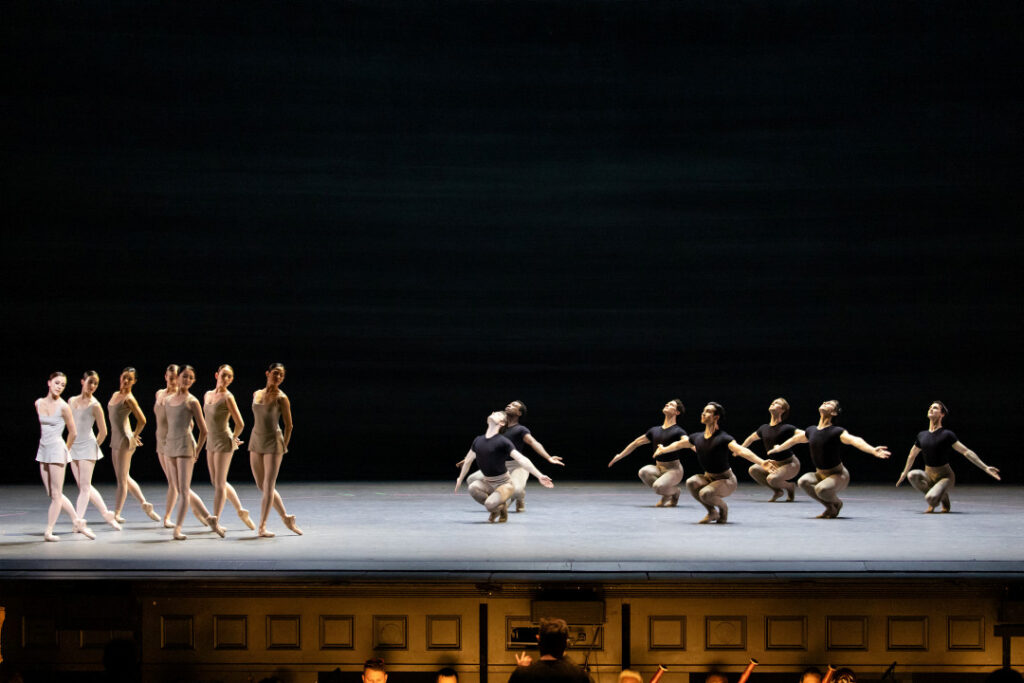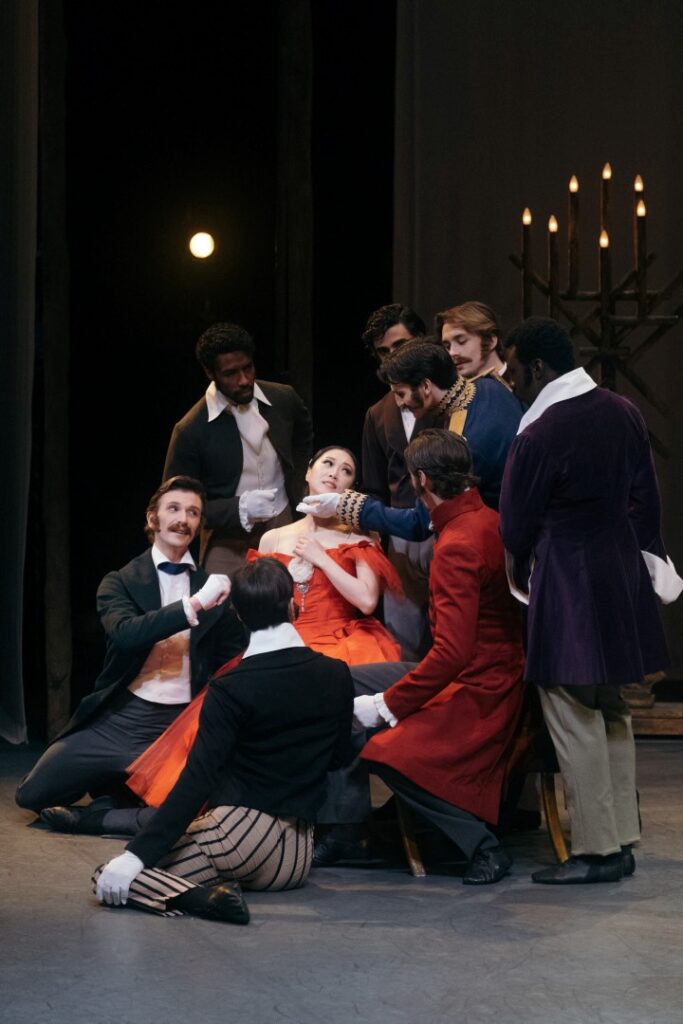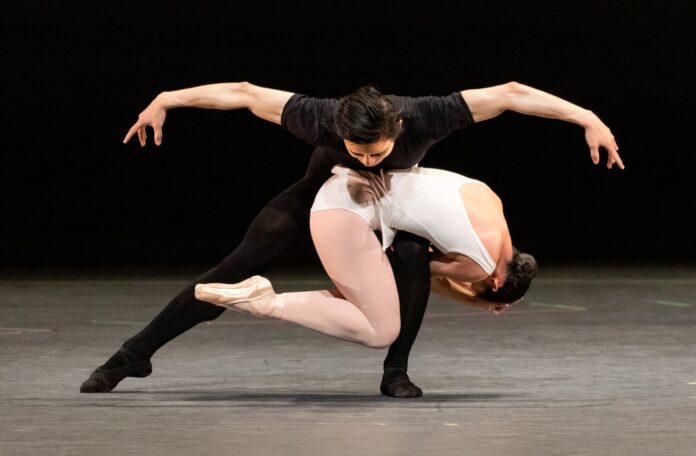It still isn’t clear what artistic vision defines Tamara Rojo’s first year as SF Ballet artistic director. If anything, her early tenure with the company has been marked by major shake-ups, including Rojo herself replacing her three-decade predecessor, as well as the departure of key dancers like Sarah van Patten. This new show marks the departure of another beloved dancer, this time stellar principal Yuan Yuan Tan.
Tan didn’t dance the opening night of British Icons (SF Ballet premiere through February 17 at the War Memorial Opera House, SF). She was replaced in her roles by Korean-born Wona Park (promoted to SFB principal in 2020) and Japanese-born Misa Kuranaga. In a way, the upstart dancers have as much to prove to patrons as their artistic director. Of course, their graceful execution of repeated on-pointe steps show that they have little to worry about in terms high expectations.
British Icons is the production of two pieces never before performed at SFB: the Kenneth MacMillan version of Anthony Tudor’s The Song of the Earth (based on the music of Mahler) and Frederick Ashton’s Marguerite and Armand (music by Franz Liszt). Both are notably challenging ballets by the late British choreographers, and seem to complement one another well when presented together: one, a story of Earthly spirits driven by passion; the other, a tale of equally-passionate lovers on the road to inevitable tragedy.

The story of Song of the Earth (such as it is) is of little concern. One needn’t know that Wei Wang’s ominous character in the Nicholas Georgiadis mask is meant to be the Spirit of Death any more than we need to know the dynamics of the ensemble members who break off into couples. The fact that our two leads are simply addressed in the program as “Man” (Isaac Hernández) and “Woman” (Park) lets us know that we’re meant to pick up everything we need on visuals alone. As staged on Georgiadis’ spartan set, the piece almost completely works. The talented dancers bring the necessary skill, and conductor Martin West knows his way around Mahler’s compositions.
What makes it awkward is the incorporation of two SF Opera veterans, tenor Moisés Salazar and mezzo Gabrielle Beteag. Their voices are fine, but their staging wasn’t thought through very well. The two switch-off scenes, standing at opposite ends of the downstage. Depending on where you’re seated, they’ll be blocking your view of the dancers on the far ends. Plus, the fact that they just stand there seems like a wasted opportunity. They needn’t be incorporated into the staging of the dancers, but they practically aren’t integrated at all. Still, the piece allows the audience to easily engage with its story.

It’s a bit more difficult to do so with Marguerite and Armand, which demands the audience already be familiar with the classic tale before observing the ballet. If not, you’ll figure out the eponymous leads (played opening night by Kuranaga and Joseph Walsh, respectively) by process of elimination, but you probably won’t know why everyone is angry, why money is insultingly thrown in someone’s face, or why the characters break up before reuniting in the climax. (Though, I assume everyone immediately picked up on Marguerite’s illness. At a certain point, one can go through several European stories and just assume everyone died of “consumption.”)
The piece works better as a showcase for Cecil Beaton’s sets and costumes, which are grand in the way Georgiadis’ were minimalist. Scene changes are signified by two floor-to-roof-length silk curtains pulled back and away from centerstage. Marguerite’s room looks like one giant bed frame draped in hanging linens. It’s definitely a triumph more of design and staging than storytelling.

As before, I went to the Opera House well-masked and wearing protective glasses for the now-mask-optional performances. Also as before, the Opera House’s grand spacing and HVAC systems—old and new—meant that my Aranet4’s CO² readings peaked around 719ppm during the two-hour show. Incidentally, I later wound up having an online conversation with a fellow SF Ballet aficionado about why the company hasn’t taken to streaming performances like their War Memorial co-residents, the SF Opera. Since all we could do was speculate, there’s no need to repeat what was said here. Suffice it to say, we both agreed that the Ballet is losing out on opportunities for both revenue and exposure by not following the Opera’s lead toward streaming.
Help us save local journalism!
Every tax-deductible donation helps us grow to cover the issues that mean the most to our community. Become a 48 Hills Hero and support the only daily progressive news source in the Bay Area.
As their patrons get older and/or susceptible to illness (particularly, the immune-compromised who haven’t been back in years), adapting to this new technological innovation is one bold change the Ballet’s new regime should be embracing. The reason we had this conversation was because we were discussing the Ballet’s last show, the tech-heavy Mere Mortals.
In her program notes, Rojo says she embraced the challenge that came with these two notoriously difficult ballets. It shows a wonderful confidence in her company that pays off in their performances. It’s to her credit that most of shortcomings of this two-parter lie in the original texts themselves. Yet, one continues to search for a grand artistic statement from SF Ballet’s new leader. The new season will bring such welcome changes as greater Latine representation in the creative process, to which I personally look forward. She doesn’t have to change the world right here and now, it’s just not yet clear what exactly she does plan to do.
BRITISH ICONS runs through February 15 at the War Memorial Opera House, SF. Tickets and further info here.






